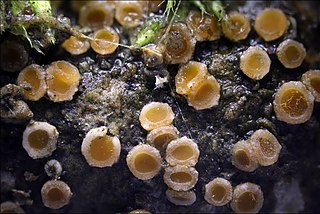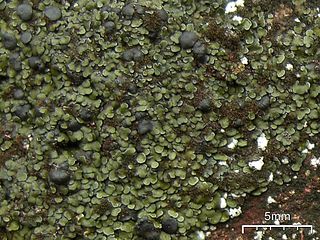
Gyalectales is an order of lichen-forming fungi in the class Lecanoromycetes. It contains 5 families, 15 genera and about 550 species.

The Sphaerophoraceae are a family of lichenized fungi in the order Lecanorales. Species of this family have a widespread distribution, especially in southern temperate regions. Sphaerophoraceae was circumscribed by mycologist Elias Magnus Fries in 1831.

The Lichinales are an order of ascomycete fungi in the class Lichinomycetes. Lichinales contains three families: Gloeoheppiaceae, Lichinaceae, and Peltulaceae. Most species are lichenized. Lichinales was proposed in 1986 by German lichenologists Aino Henssen and Burkhard Büdel.

Psoroglaena is a genus of lichen-forming fungi in the family Verrucariaceae.

Lichina is a genus of lichens in the family Lichinaceae. The genus contains seven species. These cyanolichens include maritime species such as L. pygmaea or L. confinis, in which the associated cyanobiont has been assigned to the genus Rivularia. Furthermore, evidence of a high specificity of each mycobiont towards particular cyanobiont lineages in both species has been detected.
Lichinodium is a genus of filamentous lichens. It is the only genus in the family Lichinodiaceae, itself the only member of the order Lichinodiales. Lichinodium has four species. Previously considered part of the class Lichinomycetes, molecular phylogenetic analysis revealed that Lichinodium represents a unique lineage in the Leotiomycetes—the first known group of lichen-forming fungi in this class.

Asterothyrium is a genus of leaf-dwelling lichens in the family Gomphillaceae.
Sagiolechia is a genus of lichen-forming fungi in the family Sagiolechiaceae. The genus was circumscribed by lichenologist Abramo Bartolommeo Massalongo in 1854, who assigned Sagiolechia protuberans as the type species. The family Sagiolechiaceae was proposed in 2010 to contain Sagiolechia as the type genus, and genus Rhexophiale; molecular phylogenetic analysis showed that these two genera formed a distinct clade in the Ostropales.
Leciophysma is a genus of cyanolichens in the family Pannariaceae. It has four species. The genus was circumscribed by Theodor Magnus Fries in 1865, with Leciophysma finmarkicum assigned as the type species.
Staurolemma is a genus of lichenized fungi in the family Pannariaceae. The genus was circumscribed by German lichenologist Gustav Wilhelm Körber in 1867, with Staurolemma dalmaticum as the type species.

Spilonema is a genus of lichen-forming fungi in the family Coccocarpiaceae. The genus was circumscribed by Jean-Baptiste Édouard Bornet in 1856.

Placynthium is a genus of lichen-forming fungi in the family Placynthiaceae. Members of this genus are commonly called blackthread lichens.
Stephanocyclos is a genus of lichen-forming fungi in the family Lecideaceae. It is a monotypic genus, containing the single species Stephanocyclos henssenianus. This crustose lichen was formally described as a new species in 1983 by German lichenologist Hannes Hertel as part of a set of exsiccata. The type specimen was collected from volcanic rock found on Marion Island, one of the two Prince Edward Islands in the southern Indian Ocean. The specific epithet henssenianus honours lichenologist Aino Henssen.

The Arctomiaceae are a family of lichenized fungi in the Ascomycota, class Baeomycetales. The family was named by Theodor Magnus Fries in 1861, with Arctomia as the type genus. Species in this family are found in arctic and subarctic habitats, usually associated with bryophytes.
Pulvinodecton is a genus of lichen-forming fungi in the family Roccellaceae. It has two species. The genus was circumscribed in 1998 by lichenologists Aino Henssen and Göran Thor, with Pulvinodecton kurzii assigned as the type species. Pulvinodecton differs from Erythrodecton in having spindle-shaped (fusiform) rather than doubly club-shaped (biclavate) ascospores, and by the development of its ascocarp. Additionally, the unusual pycnidia of Pulvinodecton species feature a deeply divided cavity with more than one ostiole.
Austropeltum is a genus of lichenized fungi in the family Sphaerophoraceae. The genus is monotypic, containing the single species Austropeltum glareosum, found in Australia and New Zealand.
Loxosporopsis is a fungal genus in the family Pertusariaceae. The genus is monotypic, containing the single crustose lichen species Loxosporopsis corallifera, found in northwestern North America.

Massalongia is a genus of lichen-forming fungi in the family Massalongiaceae. It has four species. The genus was circumscribed by German lichenologist Gustav Wilhelm Körber in 1855, with M. carnosa assigned as the type species.

Roccellinastrum is a genus of lichen-forming fungi in the family Pilocarpaceae. It has seven species.
Harpidiaceae is a small family of lichen-forming fungi, containing two genera and five species. It is of uncertain classification in the Pezizomycotina.










